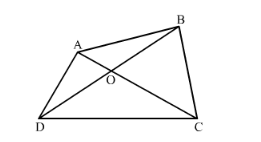The diagonals of quadrilateral $\mathrm{ABCD}$ intersect at $\mathrm{O}$. Prove that $\frac{\operatorname{ar}(\Delta \mathrm{ACB})}{\operatorname{ar}(\Delta \mathrm{ACD})}=\frac{\mathrm{BO}}{\mathrm{DO}}$.
We are given the following quadrilateral with O as the intersection point of diagonals

To Prove: $\frac{\operatorname{ar}(\Delta A C B)}{\operatorname{ar}(\triangle A C D)}=\frac{B O}{D O}$
Given ACB and ACD are two triangles on the same base AC
Consider h as the distance between two parallel sides
Now we see that the height of these two triangles ACB and ACD are same and are equal to h
So
$\frac{\operatorname{ar}(A C B)}{\operatorname{ar}(A C D)}=\frac{\frac{1}{2} \times A B \times h}{\frac{1}{2} \times C D \times h}$
=\frac{A B}{C D}...(1)
Now consider the triangles AOB and COD in which
$\angle A O B=\angle C O D$
$\angle A B O=\angle O D C$(alternative angle)
$\angle B A O=\angle D C A$(alternative angle)
Therefore, $\triangle O D C \sim \triangle O B A$
$\Rightarrow \frac{A O}{O C}=\frac{B O}{D O}=\frac{A B}{C D}$
$\Rightarrow \frac{B O}{D O}=\frac{A B}{C D}$...(2)
From equation (1) and (2) we get
$\frac{a r(A C B)}{a r(A C D)}=\frac{B O}{D O}$
Hence prove that $\frac{a r(\triangle A C B)}{a r(\triangle A C D)}=\frac{B O}{D O}$
Click here to get exam-ready with eSaral
For making your preparation journey smoother of JEE, NEET and Class 8 to 10, grab our app now.
